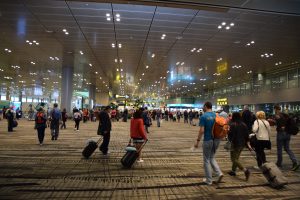Pathological (im)mobilities: Managing risk in a time of pandemics
March 23, 2022

In January 2020, Changi Airport saw a record of 5,950,000 passengers, a 5.2 percent year-on-year increase, even as the first imported cases of COVID-19 were beginning to appear. At that period of time, people were still able to enjoy nearly uninhibited access to Singapore. With the conventional wisdom at that time being to manage, and not halt any intrusion of the disease, borders only virtually shut on March 23, 2020.
In ‘Pathological (Im)mobilities: managing risk in a time of pandemics’ (Mobilities, 2021), Assistant Professor Lin Weiqiang and Professor Brenda S. A. Yeoh (NUS Department of Geography) reflect upon the COVID-19 developments in Singapore between January and December 2020. Though the Singapore government was initially hesitant towards isolation from the rest of the world, it was seen to move incrementally towards tightening domestic and international mobility, which culminated in the ‘circuit breaker’ restrictions in April 2020. This turn of events was not solely due to the sudden spike in infection cases after March 2020, but also because of the increasing failure of existing mobility controls to contain pathological risks in Singapore’s cosmopolitan society.
In the article, Dr Lin and Prof Yeoh analyse policy maneuvers and news reports to examine the gradual slowing down of aeromobility amongst different groups (tourists, businesspeople, expatriates, and overseas citizens), and the quarantine of low-skilled migrant workers in the face of unanticipated dormitory outbreaks. In both cases, Dr Lin and Prof Yeoh state that since people were accorded with different levels of mobility both within and beyond national borders depending on the level of citizenship they had, (im)mobilities once thought to be non-risky turned out to be high-risk. Therefore, Singapore’s response to COVID-19 highlights the unevenness of resource distribution and citizenship rights among different transnational groups and underlines the danger of the discriminatory division of transnational flows.
Dr Lin and Prof Yeoh use the conceptual lens of ‘pathological mobilities’, to refer to how the COVID-19 pandemic relies not just on a virus, but also human organisation to further spread. These ‘pathological mobilities’ consist of two facets. The first is literal, and more epidemiological in nature in how the movement of people contributes to the distribution of diseases. The second is figurative and social-moral in how certain groups such as migratory non-workers are often viewed to be ‘unwanted wanderers’ likely to negatively impact a society’s state of safety. Thus, ‘pathological mobilities’ enable the tracing of COVID-19’s spread beyond the current movement of people, but also the existing patterns of (im)mobilities that preceded the pandemic. The pathologizing of certain mobilities and not others becomes a method of which risk is rendered visible, calculable, and manageable, allowing organisation to be better achieved.
However, those who are deemed to be ‘pathological’ risks will have a differentiated flow of mobility than others, affecting their life chances and promoting greater marginalization. The creation of ‘pathology’ in this case draws on an imprecise algorithmic science. The marginalization of the homeless and the migrant causes them to have a heightened susceptibility to epidemiological risk due to their lack of access to housing and healthcare. At the same time, they are most likely to be viewed as requiring the highest level of surveillance for potential health risks. This causes these groups to be more marginalized and managed, causing a self-fulling prophecy where marginalization leads to greater risk, and vice versa.
Read the article here.
